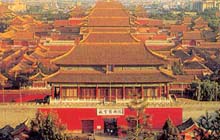
 Home of the Emperor, the Forbidden Palace was constructed in accordance with the laws of geomancy or fengshui. Every element was considered according to its prescriptions, the most fundamental being the positioning of the palace along a north-south axis.
Home of the Emperor, the Forbidden Palace was constructed in accordance with the laws of geomancy or fengshui. Every element was considered according to its prescriptions, the most fundamental being the positioning of the palace along a north-south axis.
The occult art of numerology similarly played a significant part within the palace's architecture. Since odd numbers are thought to be masculine and even ones feminine, the number nine, the "ultimate masculine" number, was associated with supreme Imperial sovereignty. It is therefore employed continuously in the palace, for instance in the number of studs on the gates. Likewise, the towers guarding the four corners of the palace each have nine beams and eighteen columns. But its most conspicuous application is in the fact that the Forbidden Palace is comprised of 9,999 rooms.
A further element differentiating palace architecture from other traditional Chinese forms includes the specific designation of colored glazed tiles. While these were applied to the roofs of many aristocratic homes, the use of yellow tiles was exclusively reserved for Imperial palaces, mausoleums, gardens and temples. The association of the color yellow with the Emperor originated with the idea that the great Yellow River was the cradle of Chinese civilization. As a result yellow also represents the concept of earth in the Chinese occult universe. Green was used on palace buildings reserved for court officials, while red, signifying happiness and solemnity was generally used on doors.
Prevalent throughout the palace are elements of zoomorphic symbolism. The most apparent of these is the use of the dragon and phoenix, symbols of the emperor and empress. Omnipresent in the palace, these legendary animals have been found on objects dating back as far as three thousand years. Another frequently seen animal is the lion who guards various entrance gates. Always found in a pair, the lion on the left is male and holds a ball symbolic of imperial unity. The one on the right is female and plays with a lion cub, symbolic of fertility. As the lion was thought to be the ruler of the animal kingdom, it represented qualities of power and prestige.
Interesting also are the animal ornaments found on imperial rooftops. The mystical animal at the outermost tip was thought to be the son of the Dragon King-ruler of the sea. With powers over the waters, this animal was thought to protect the palace buildings from fire. Along the roof edges are various smaller animals, the sizes and numbers of which differ according to the rank and status of the dweller within.